Everyone loves those amazing, deciduous, shrubs, in full bloom during the spring, and adorned with thick foliage throughout the fall and summer time. No one really likes looking at a bunch of tangled, dull, gray, branches all winter long. Let’s face it, you’re never going to post pics of dead branches on social media, only thing going on Instagram are those amazing blooms during the spring and summer. Even though deciduous shrubs lose their leaves during the winter, and can look bare and dead, there are a few specimens that still offer some pleasing aesthetics throughout the cold winter months. Here are our top five picks.
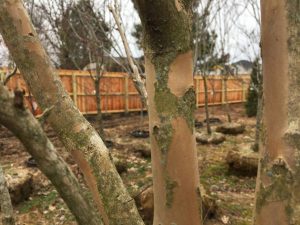
Natchez Crape Myrtle Exfoliating Bark
#5 Natchez Crapemyrtle
Lagerstroemia x ‘Natchez’
The Natchez Crapemyrtle, often spelled crape myrtle or crepe myrtle, is a heat loving, drought tolerant, large shrub or small tree features glossy dark green foliage emerging in late spring, followed by panicles of pure white, soft textured flowers throughout the summer months and into the fall. The foliage changes to a fiery orange red during the fall months, and begins to shed before the winter months arrive. The tall, elegant, thick stems, feature smooth, exfoliating bark all winter long. A gray top layer, gives way to a dark cinnamon-brown mid-layer, followed by a light, creamy tan layer underneath, providing a unique display during the dormant winter months. Natchez is usually grown as a multistem, large shrub, but can be grown as a small, single trunk, ornamental, tree, offering yet another unique feature to an otherwise dull winter landscape.
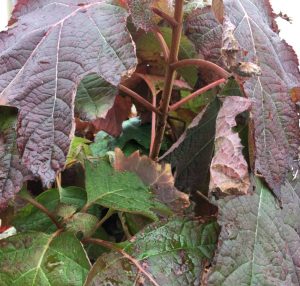
Oakleaf Hydrangea Winter Interest
#4 Oakleaf Hydrangea
Hydrangea quercifolia
This large, multi-stemmed shrub, growing 6-8 feet tall and as wide, is a shade loving, native, to the Southeastern region of the United States. As the name suggests the oakleaf hydrangea features large, up to 9 inches across, lobed, oak-like, dark, green, leaves, emerging in early spring. These are followed by panicles of white flowers throughout the summer and into early fall. During the fall months the leaves change to a brilliant burgundy red and persist into winter. In milder winters, the foliage may remain into late winter, only shedding as new buds begin to form. Dried flower heads often remain giving this lovely, native, hydrangea a spot on our list of winter interest shrubs.

Henry’s Garnet Sweetspire in the winter
#3 Henry’s Garnet Sweetspire
Itea virginica ‘Henry’s Garnet’
As its name indicates, Henry’s Garnet features upright, arching, dark, burgundy-garnet, colored branches, neatly packed to create a denses rounded shrub, about 4 feet tall and up to 6 feet in width. During the early spring months, dark, green, oval shaped leaves emerge followed by cylindrical shaped, drooping, racemes with an abundance of tiny, fragrant, white flowers persisting into the summer months. This North American Native features stunning shades of red, orange and gold, transforming this specimens foliage into an amazing display of fall color, often persisting into winter. When the leaves are finally shed, the beautiful, burgundy-garnet colored branches, upright and slightly drooping, offer winter beauty that stands out in an otherwise gray backdrop.
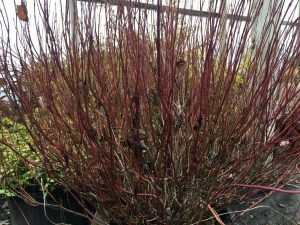
Red Gnome in the Winter
#2 Red Gnome Dogwood
Cornus alba ‘Regnzam’
This beautiful, compact, 3-4 Feet tall and as wide, flowering, dogwood shrub offers an amazing display of creamy, white, bloom clusters, backed by large, dark, green foliage during the spring and early summer months. Flowers give way to small, white, berries that mature in mid summer. During the fall months, Red Gnome’s foliage changes to a brilliant burgundy before shedding its leaves for the winter months. It is this time of the year, winter, when the Red Gnome, lives up to its name. The falling leaves reveal this specimen’s true beauty, of its thick, uniformly, dense, upright, branches are a bright red color, offering a truly beautiful addition to the landscape during these dormant months.
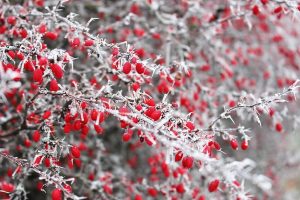
Showy red berries on the Winterberry Holly
#1 Winterberry Holly
Ilex verticillata
And for our number one pick, the name, Winterberry, brings visions of brilliant, red berries encapsulated in ice against a snowy, white, wintery, backdrop, to the mind. And for good reason. That is exactly what the Winterberry Holly does. This brilliant, North American, native, deciduous, holly, offers a phenomenal display of large, ¼” in diameter, bright, red berries, all winter long. Often even persisting into the early spring months. This medium sized shrub, 6-8 feet tall and as wide, offers dense, dark green foliage emerging in early spring, followed by small, inconspicuous, greenish-white, flowers. If a male pollinator is nearby, the beautiful red berries, this plant is famous for, will emerge in the late summer to early fall, set amongst still dark green foliage, which begins to shed in the later fall months. Leaving the spectacular vision of winter this shrub is named for.
We carry all of the plants on our list, talk to your landscaper about adding one, or more, of these beauties to your landscape.

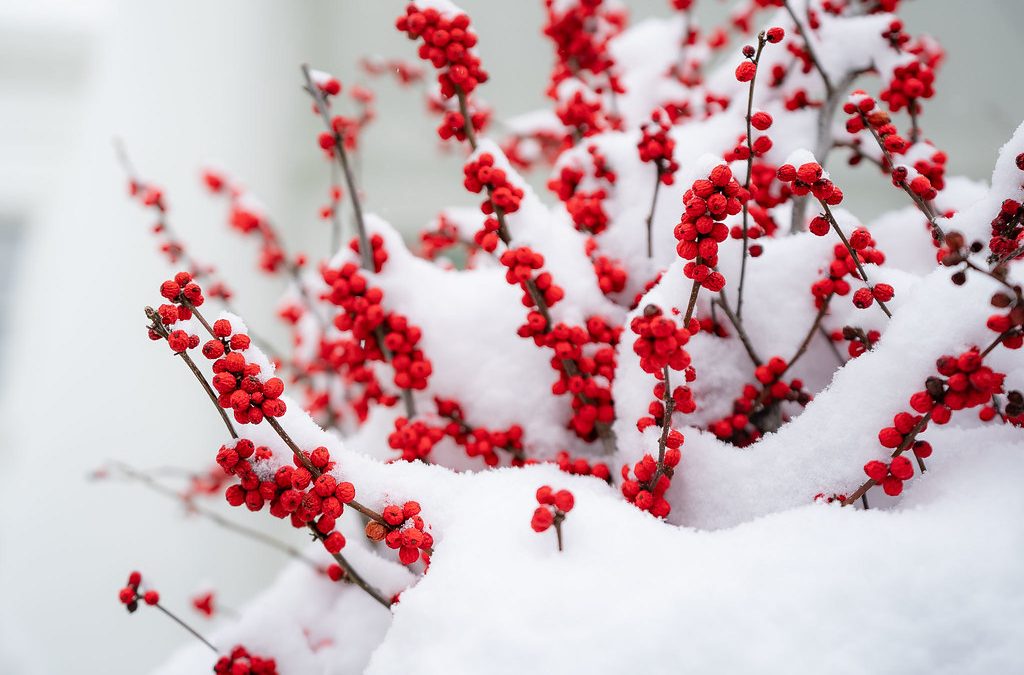
Recent Comments